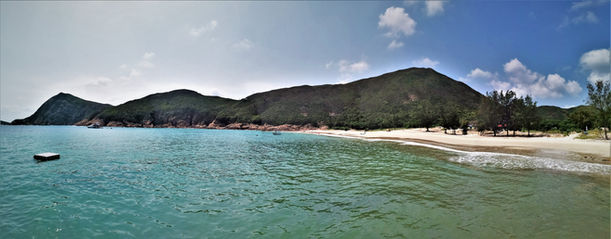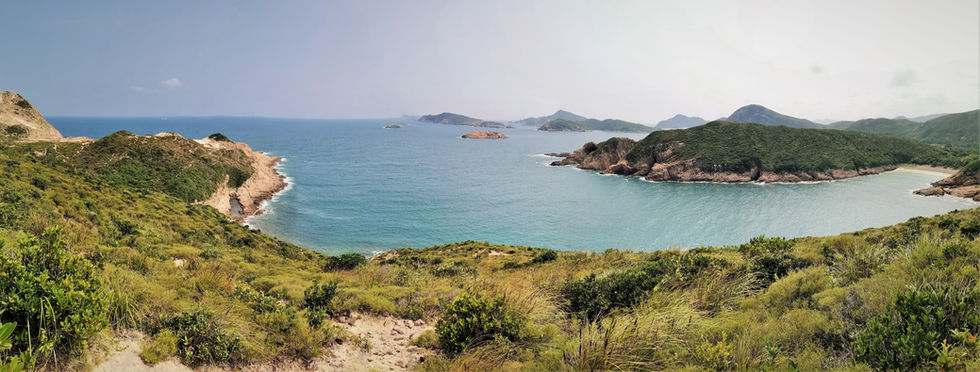
Hiking in Hong Kong
High Island (the off-road route)
Distance: 22.4 km
Time: 6 hours 40 minutes
Ascent: 940 m
Date: September 2022
Start: PAk Tam Chung
End: East Dam Wall

Explore this place if:
-
you want an alternative to the road across High Island
-
you love coastal views and hexagonal rocks
Avoid this place if:
-
you want a clear, easy-to-follow trail where you can see your feet
-
you don't want to end up scratched, grazed and bleeding at the end

High Island is a bit of a misnomer. It is neither very high, nor is it an island anymore. The highest altitude I achieved was 122 m, although there were mountains closer to 300 m that I didn’t climb. By Hong Kong’s standards, this still isn’t particularly high.
In the 1960s, High Island was an actual island - the fourth largest in Hong Kong. Today, it is connected to the mainland by a dam at each end, with no boats or ferries required to reach it. A smooth road extends all the way across the north side, which is a popular walk due to it being part of the 100 km-long MacLehose Trail. I’ve trekked it before, and it is not fun. While the reservoir and bay views are photo worthy, it doesn’t feel like real hiking.
As I was researching hikes around the Sai Kung peninsula (to which High Island is attached), I noticed an off-road trail stretching along the southern coast. There were very few details about this trail online (some sections had zero information), so naturally I was determined to explore the area. I was also keen to see the famous hexagonal rocks of the island up close, something I didn’t get the chance to do while traversing the MacLehose.
The first stage of my hike started on the mainland, at a large bus stop on a quiet road. Within minutes I arrived at the Pak Tam Chung Nature Trail, a paved path running alongside a river. Unfortunately I didn’t see much of the water due to the tall vegetation on either side of me. The only break was a small pier jutting out over the river, providing me with almost perfect reflections of the surrounding mountains.
After one kilometre, I turned onto the Sheung Yiu Country Trail. Initially I was climbing up a set of rocky stairs, but at the top I was ecstatic to find an undulating dirt path running for 3 km through the forest. The track was wide, clear and relatively empty - it would have made a much better start to the MacLehose Trail than the road. Even though I only caught the occasionally glimpse of the bay below me, it was a pleasant way to start the day. If only it had stayed that way.

The trail ended at the main road, where I encountered dozens of walkers undertaking the first stage of the MacLehose. Unobstructed reservoir views definitely made for a picturesque walk, but I still preferred my shady, off-road route. Not long later I crossed the West Dam wall - I was now officially on High Island.
As soon as I could, I turned off the road and onto a minor street heading downhill towards the southern coast. If I wasn’t looking at my map, I never would have found the entrance to the trail I was after. I entered through a small gap in the trees, where I passed a sign that had fallen over. It read ‘road closed’, indicating I shouldn’t progress any further. I ignored it.
I soon regretted that decision. To say the path was overgrown was an understatement. I did not see the trail, or my feet, for most of the next couple of hours. Rocks and boulders tripped me up at every opportunity, branches scratched my legs to shreds, and sweat was pouring down my face. The pace was ridiculously slow. No wonder this path didn’t have a name, or any information online. I wondered how long it had been since anyone had been along here. Multiple times I thought about turning around, but I silently hoped that this hell would end soon and it would open up to a well-maintained, easy-to-hike trail.
It didn’t. I was given a momentary respite when I popped out at a tiny, rock-filled beach lined by abandoned buildings. I guess they were abandoned for a reason, because there was no easy way to reach it. The torment continued as I made my way back into the wilderness. As I ascended a hill, I could see boats in the bay below me, with music and laughter reaching my ears. There was no laughter coming from me.



4.5 km and a couple of hours later, I arrived in Pak A, a peaceful, seaside town with not a lot going on. The only people I saw were runners/swimmers taking part in a training session - they were the first people I had seen since entering the ‘closed road’. At this point, I was ready to throw in the towel and walk up the easily-navigable street to the main road, but I glimpsed the trail to the next town. From my vantage point, it looked entirely clear and entirely paved. My mind went back and forth, trying to make a decision. I ploughed on.
A kilometre further on I hit a temple, where I found a tap to wash myself off. I was absolutely filthy. My legs were bleeding from multiple places and red raw from the continual assault. Dirt covered every exposed area of skin. Bits of vegetation were stuck to my arms and clothes. It took a while, but I managed to look less like a savage and more like your everyday hiker by the time I was done.
Once I climbed up and over another hill I arrived in Pak Lap. I hadn’t heard of any of the villages on the island, so I had no idea what to expect. Pak Lap was like an oasis. I could see the beautiful white beach as I was coming down the hill, but the highlight was finding a cafe that was open and fully stocked. Several kayakers were eating lunch, yet I was only interested in fluids. I stocked up on cold water and coconut water, both disappearing instantly. Sitting on the outdoor furniture, I woofed down my packed lunch while listening to the water lapping on the shore and appreciating the cool breeze. I didn’t want to leave.

On my map I saw that Mok Min Cave was not far from Pak Lap, so I decided to check it out. After passing my first lot of hexagonal rocks for the day, I found the path leading to the cave. Of course, it was overflowing with vicious bushes that caused excruciating pain to my tender legs as I brushed past them. As I climbed higher, I was rewarded with views over Pak Lap and the rugged coastline. Unshaded paths crisscrossed all over the place, and I had no idea which one was the main trail. In the end it didn’t matter. They all led to the top of a cliff, from where I was required to carefully lower myself down the almost vertical jumble of rocks. There came a point, about halfway down, where I was not prepared to descend any further. I couldn’t really see the cave, but the coastal scenery was spectacular.
I trudged back inland before turning east, hoping to find that paved path again. I didn’t. The suffering continued, but this time it was intensified because I couldn’t find the correct route. It took several attempts before I found something resembling a trail. This trail carried me out to two small beaches, both of which were filled with watermelon-sized unstable rocks. I don’t know how I didn’t roll an ankle.
The following stage involved negotiating a tall hill in the blazing sun. My legs were on fire, inside and out, I was dehydrated and tired, and I could barely turn around to look at the view. After a quick descent I arrived at the last climb, at the eastern end of the island. The route carried me up to a lookout over the minuscule island of Po Pin Chau, which seemed to consist only of hexagonal rocks. I had the place to myself, and while listening to the waves crash against the cliffs, I took a moment to soak it all up. I couldn’t believe I had survived High Island.






My next destination was a sea cave below the East Dam wall, which marks the end of the island. Technically, I was supposed to take the long way around along the marked path, but I saw several women taking a shortcut straight across the side of mountain. If it could save me a couple of kilometres, I was keen to give it a go. The first section was easy, walking along a clear, rocky path. Then the path disappeared. I found myself holding on tight as I skirted along a precipitous rock wall before edging down an open halfpipe on all fours. After several heart-thumping minutes, I was relieved to land on solid ground. From here, I clambered over small boulders and under gigantic dolosse (20-tonne concrete wave breakers) to reach a sign saying ‘no climbing the rocks’. I hadn’t listened to any other signs today, so why start now.
While navigating over the rocks, I could see why the sign was there. It was a little dangerous, but as it was taking me directly to cave, I kept going. Ahead of me, several metres in front of the cave, was the main path, the one I was technically supposed to be on this whole time. The only problem was that the path ended in a boardwalk over water, which I couldn't reach without going for a swim. Thankfully, there wasn’t much water inside the cave, so I could walk right up to the entrance, where reflections glistened in the small pond in front of me. I was glad there was no one on the boardwalk, otherwise I would have been in all of their photos. Walking out the other side, I undertook more semi-dangerous rock scrambling up to an area where the boardwalk met dry land. From there, it was an easy walk along the pavement up to the East Dam wall, admiring hundreds upon hundreds of hexagonal rocks up close. Some had twisted into a vague S-shape due to the effects of geological pressure. They glowed a golden reddish-brown in the late afternoon sun. It would have been more fascinating if I wasn’t so exhausted.
Once I was on top of the wall, I decided to go for a final quick hike up a hill to the Biu Tsim Kok viewpoint (this section was not on High Island). Along the way, the views out one side to Long Ke Wan Beach were stunning - it is easily one of my favourite beaches in Hong Kong. On the other side of the hill, the sun was starting to go down over the High Island Reservoir, turning the surface of the water a glassy silver. At the viewpoint, I was granted a panorama out across sea, all the way around from the beautiful beach to the reservoir, with another set of hexagonal rocks lining the cliffs in the distance. Then it was an easy walk back down to the East Dam wall, where I jumped into a taxi to take me back to civilisation.













































